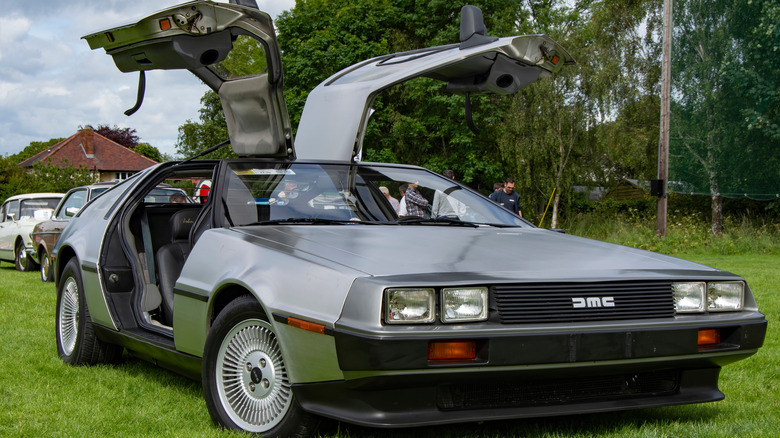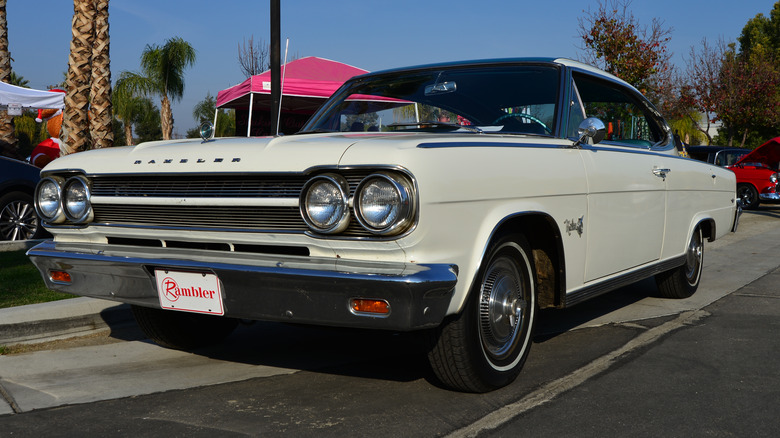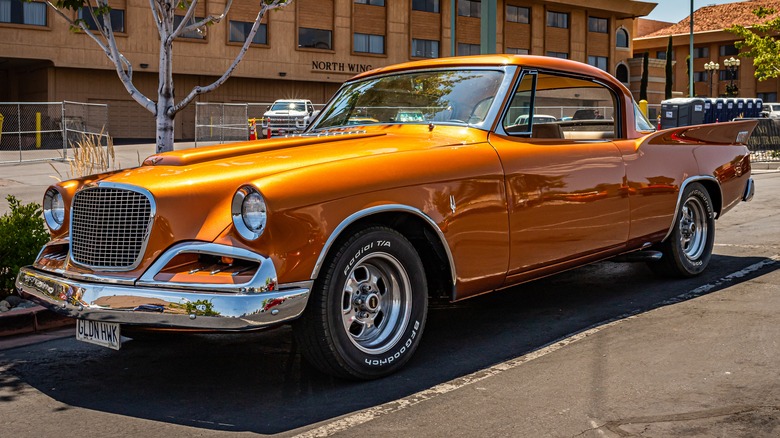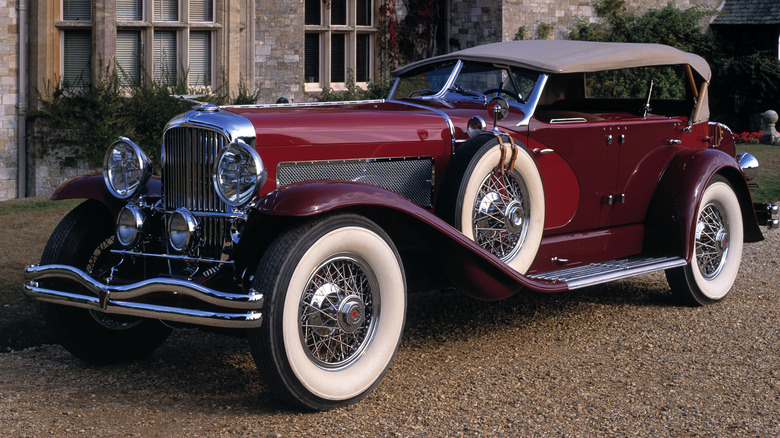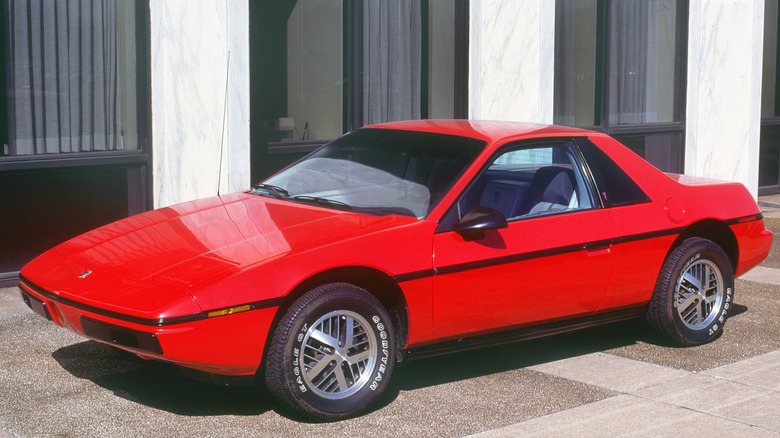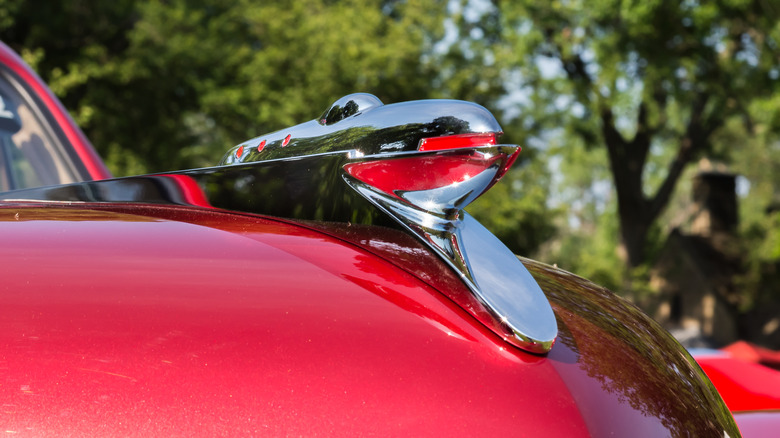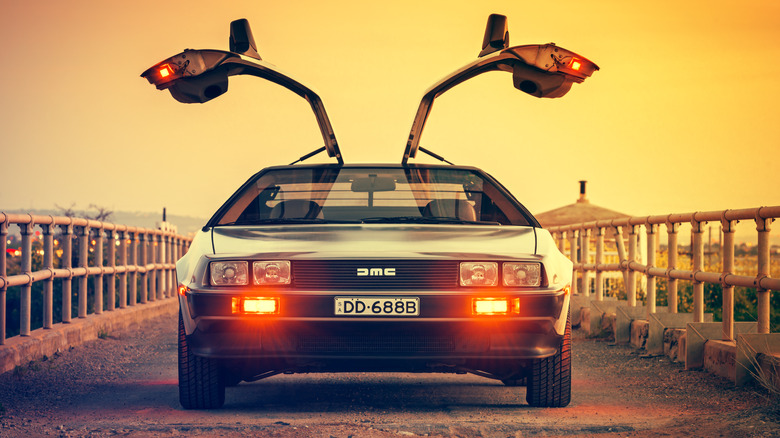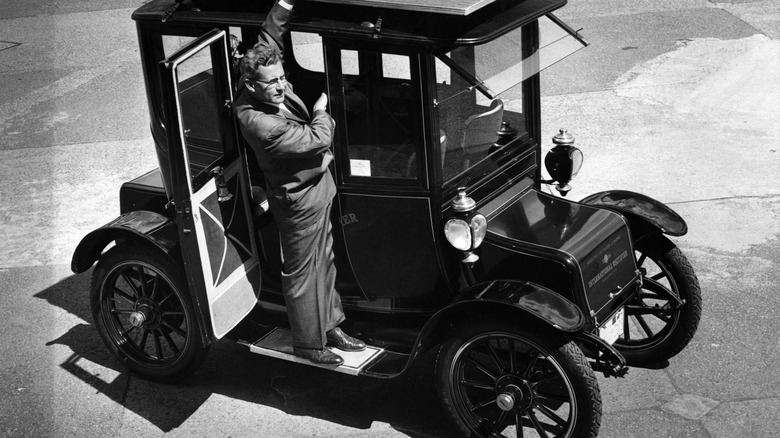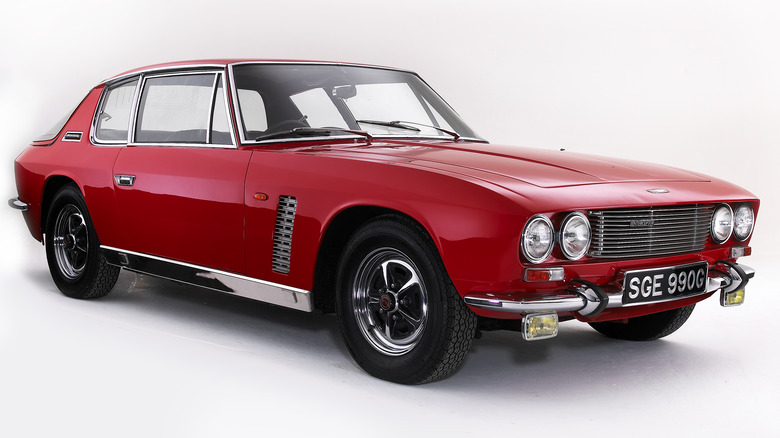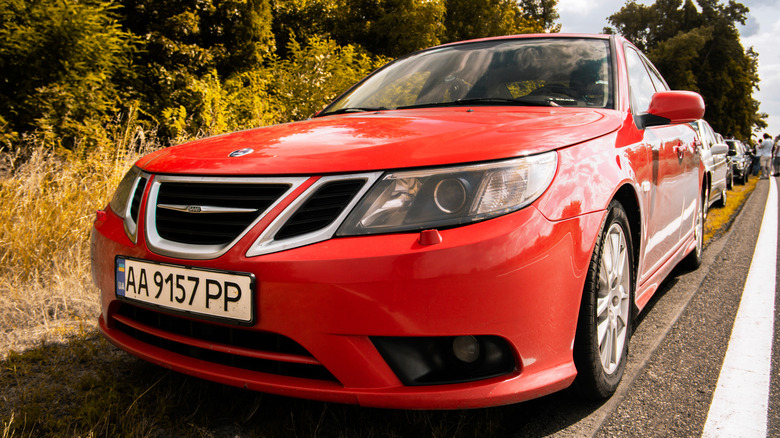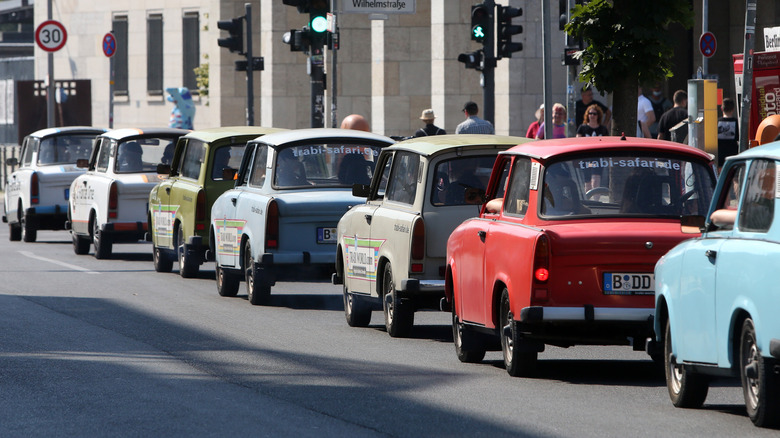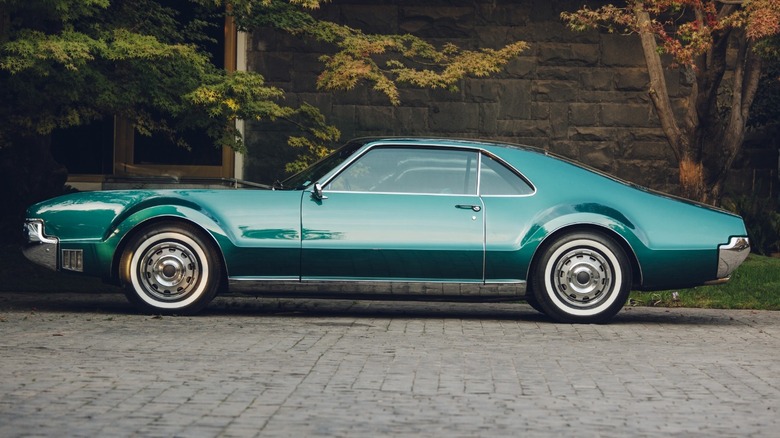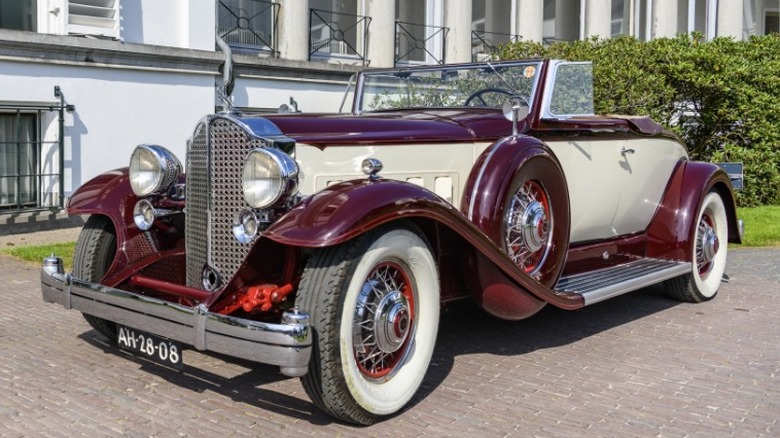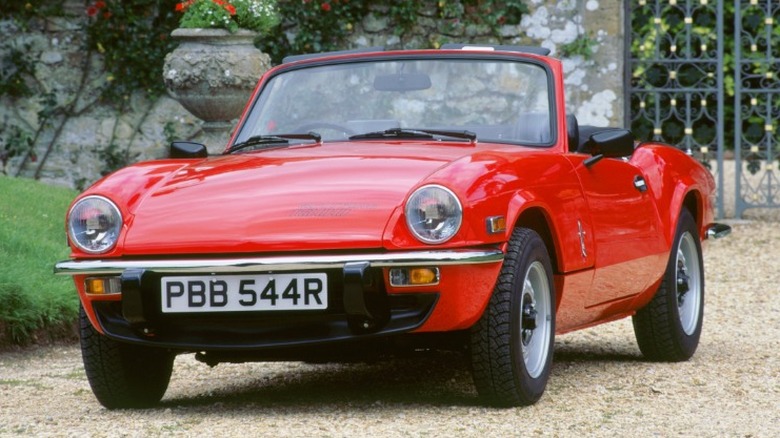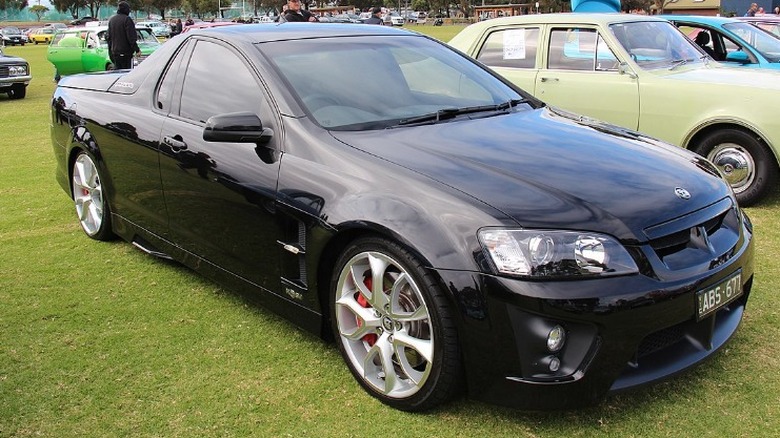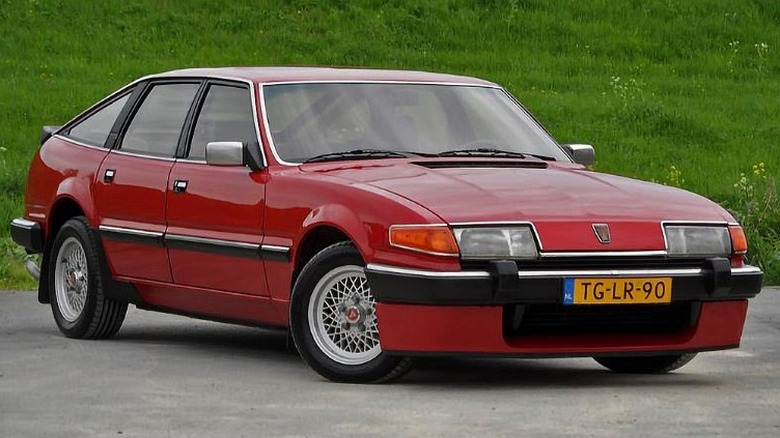15 Defunct Car Brands We Wish Still Existed
The number of automotive manufacturers that have existed since the end of the 19th century is staggering. Reasons as diverse as economic depression and recession, mismanagement, changing trends, and outright fraud have brought down many storied — as well as obscure — marques. Indeed, the annals of auto history are fraught with tales of the destruction and demise of much-loved automobiles.
Occasionally once-dead automakers achieve success through revitalization, such as Bugatti and Spyker. Others have seen attempts to restore former glory crash and burn into notorious failure. The Stutz brand is one that saw this sort of successful resurgence only to die — followed by another attempted resuscitation just to, as outlined by Forbes, once again be lost and possibly gone forever.
Despite these successes and failures, it is often an interesting and even slightly emotional exercise to ponder a future where these manufacturers did not succumb to the pressures of the marketplace and lived to see another race day in the modern era. These 10 marques deserve a second act in the 21st century.
1. American Motors Corporation
Always the underdog of the American auto landscape, AMC was an inventive manufacturer that produced many fan favorites. With such powerhouses as the Marlin and AMX, as well as the trusty Rambler and Eagle, AMC excelled in finding an unserved niche and filling it with a model unlike any other. If it had continued to survive despite its underdog position, there is no doubt modern AMC vehicles would still be cut from a different cloth.
While it would have to produce SUVs out of competitive necessity, the brand likely would have maintained its lineup of fun compact cars and wagons that most American manufacturers are abandoning. Adding to that, a modern version of the AMX could give the C8 corvette some real American competition. AMC was always the little car maker that could, and it would be fun to see what they could have done with the amazing engineering and technology of the 21st century.
2. Studebaker Corporation
Another underdog of American manufacturers, Studebaker is known for having produced well-built and interesting cars and trucks that stood out amongst the burgeoning American auto industry of the late 1800s. As noted by the Smithsonian Libraries, Studebaker began as a builder of horse-drawn carriages and would be the oldest automaker if it still existed today. While not known as a performance car manufacturer, it did make some impressive V8 engines, including some with a supercharger.
One such model that would be a fascinating modern car is the Hawk. This was their luxury coupe that paired V8 power with stunning good looks and comfort. Today it would very likely have a downsized engine powered up with turbo and/or supercharging. According to the Smithsonian Institution, Studebaker also bought the Paxton Corporation, a maker of superchargers. It would be easy to see that relationship leading to modern supercharged rockets taking advantage of advances in engineering and forced induction coming from the South Bend, Indiana automaker. Studebaker could be a fierce competitor to Buick or Volvo, slated in the upscale, yet not-quite-luxury market.
3. Duesenberg Motors Company
Sitting comfortably atop the hierarchy of luxury automakers in the early 20th century, Duesenberg was known for producing the finest automobiles in the world for the most discerning and demanding of customers. Being an extremely expensive car, it was the automobile of choice for the wealthy from actors to gangsters, per Discovery UK. Not only was Duesenberg known for opulence, but it also delivered superb engineering, developing some of the most powerful production engines of the pre-war era.
If it had survived the Depression, Duesenberg would still be a rival to Rolls-Royce and Bentley, delivering a car for the rich and famous that would fly past our current luxury marques, Lincoln and Cadillac, by leaps and bounds. No shortage of automatic and hands-free accessories or turbo power would befall a modern Duesenberg. These days, the brand would still be the standard of American luxury to which all other automakers would aspire, just the way brands did back in its heyday.
4. Pontiac
While the keeping of so many brands within General Motors may have seemed redundant, Pontiac offered unique, fun, and sporty alternatives for decades. While legitimate arguments exist for why it went under, Pontiac more often than not lived up to their motto of "We Build Excitement." One of the defining features of the brand was its inclusion of sporty cars that were attractive and fun to drive, yet not overpriced.
They often were a little more refined than their Chevrolet counterparts and offered more options to create unique models. Certainly, a modern Pontiac would include the legendary Trans-Am based on the current Camaro, but it could easily pick up the reins of the Fiero with a fun two-seater electric sports car. With Chevy and Buick mostly churning out variations of the same two-box SUV, Pontiac would be well suited for creating a niche performance brand within the General Motors family of automobiles. It may well be time to bring all that "excitement" back to the mainstream.
5. Tucker Corporation
It takes a true visionary to take on established and entrenched industrial organizations and attempt to outfox them at their own game. This has been true with Tesla as Elon Musk reframed the orthodox thinking about what a car should be and do and turned it on its head. If Tucker had Musk-level cash to finance his vision, that may not be the case.
Preston Tucker wanted to bring to market a car that excelled in all the areas in which the big three and others didn't just fail, they failed to even see there was a failure taking place. Smithsonian Magazine details the litany of safety features he wanted, including mind-blowing innovations such as seatbelts, padded dashboards, and windows that popped out in the event of a crash in an era long before safety was incorporated into auto designs.
Tucker, the man and the company, were both reduced to nothing by a bogus SEC investigation and sensational reporting, as recounted by Wired Magazine. If not for these unfortunate events, we may well have the safest electric car on the American roads wearing a Tucker badge instead of Tesla. The ideas Tucker wanted to implement were ahead of their time and a modern Tucker would surely be at the cutting edge of auto development if it only could have survived.
6. DeLorean Motor Company
With decades of experience running divisions of the largest car company on Earth, John DeLorean brought plenty of tried and true ideas to his company. However, good ideas don't necessarily make for a good company. Nonetheless, the DMC-12 automobile he created has left a lasting impression in popular culture and continues to be a fixture in the folklore of the American car enthusiast.
At the time of its release, the DMC-12 was a car that sought a very niche audience. The number of people who can afford to purchase a high-end, two-seat sports car with virtually no practicality is sparse. This has always been true, but the current market seems to have plenty of room for high-end automakers with foolishly impractical yet absurdly powerful speed machines. A modern stainless steel gullwing sports car could have a place in today's market.
The modern DeLorean would surely be electric, but had it been revived sometime in the early 2000s before the company's namesake had passed, Delorean could have easily picked up an Audi V8 in the way Spyker did or have AMG engineer a hefty turbo V6 with plenty of power. With John DeLorean's passing in 2005, his legacy shall always be sealed firmly in the past, along with a kid named Marty heading 88 mph into the future.
7. Baker Motor Vehicle Company
One of the bestsellers of the Brass Era of automobiles, which ran roughly 1896 to 1915, the Baker Motor Vehicle Company would fit nicely into the current landscape of motoring. More than a century before the emergence of Tesla as the leader in electric vehicles, Baker boasted impressive sales of up to 17 battery-powered vehicles, according to Classic, including one of the first vehicles bought for the White House fleet.
While the convenience and power of internal combustion quickly eclipsed the limitations of electric propulsion, for a time, the Baker electric car was one of America's top sellers. Car and Driver reports that in 1903, an engineer for the company managed to achieve a range of 201 miles from a single charge, albeit only while traveling 12 mph. A modern Baker Motor Vehicle Company would fit in very well into the EV revolution, wielding its authority as an original innovator in the space.
8. Jensen Motors Limited
More familiar to British audiences, Jensen's were unique, innovative, and powerful cars for the "English gentleman." From the start, Jensen was always more of a coachbuilder and produced bodies for other manufacturers in the pre-war era, notes MyAutoWorld (original article now defunct). Some of their first original creations sat atop other manufacturers' chassis and drivetrain configurations.
Later models came about being fully manufactured by Jensen, but still using other companies' engines. One of its most loved models was the Interceptor, which was powered by a massive Chrysler Hemi V8. Australian Jensen Club Magazine states that the Jensen Interceptor FF was the first all-wheel-drive production sports car in 1966. Being a small independent company meant that they had to pool their resources with others, and when they did, created some phenomenal machines.
Should Jensen Motors exist today, it is possible they would be a clever and niche brand utilizing the vast development capabilities of Ford or VW to build fast and fun cars that are generally unattainable for most people, but not exclusively affordable to the ultra-wealthy. Even a modern proper British sports car powered by a Hellcat V8 would be an interesting proposition.
9. Saab Automobile AB
Among the quirkiest of automotive brands, Saab cranked out unique cars using meager budgets paired with ingenious Swedish engineering solutions. Among the many quirks of a Saab are the location of the key in the center of the console between the front seats, and the placement of their slanted 4 cylinder engine in reverse, such that the clutch is actually in the front of the car and the driven accessories are toward the back of the engine compartment against the firewall.
Saab fell victim to the financial crisis of 2008 during the restructuring of General Motors, which decided to sell the brand off to the highest bidder, as reported by The New York Times. The attempt by boutique car maker Spyker to keep the storied Swedish marque afloat ended in abysmal failure, with the pieces of Saab picked up by a Chinese company that, according to Motor Trend, has since gone bankrupt and later been revived as an electric mobility company. At the time of its demise, Saab had concept cars and new platforms in the works and had just released an all-new Saab 9-5 model. The Spyker-led company managed to produce only 3,419 of the new 9-5 models before production ceased, per eSaabparts.com.
It is likely a modern Saab would have continued on this path, creating new hybrid and electric models with updated styling. Without the calamity that was the 2008 financial crisis, there is no reason to think that Saab would not be here today.
10. Trabant
Of all the cars one would want to see revived, a terrible, smoky, unreliable rattlebox from East Germany is not likely to be on the list. One might question the sanity of reviving such a brand, but there are at least a few reasons to substantiate. For the uninitiated, the Trabant was a compact car produced in communist East Germany from 1957 to 1990 (production continued after German reunification, but ended in 1991). It was a small, poorly built little car with no power windows, no power seats, and generally no power at all. It was propelled by a 2-stroke, 2-cylinder air-cooled engine producing 26 horsepower coupled to a four-speed column shift transmission.
By all accounts, it was not a good car, an objective fact attested to by Motor1. But for lucky and loyal socialist party members of the DDR, or East Germany, it was a treasure. It is no surprise with the fall of the Berlin Wall that the inefficient and outdated Trabant would cease production. But with the modern automotive industry offering few, if any, truly small and affordable cars, Trabant could fit into its own low-end niche.
The thought of young professionals and college students tooling around in a modern Trabant complete with all of its original styling is not so far-fetched. If vinyl records can once again dominate the sales charts, there's no reason Trabant couldn't, too.
11. Oldsmobile Division of General Motors
Ransom Olds was among the early pioneers of the American auto industry. While Henry Ford is often erroneously credited with creating the automobile assembly line, it was Olds who first put it to use — Ford was first to automate the assembly line (via Robohub). Oldsmobile was acquired by General Motors in 1908, continuing as a division that sat in the middle as an upscale brand that offered well-appointed cars for an affordable price.
Oldsmobile made some great cars in its time. Anyone alive during the '80s knows the Cutlass well as they had been the best-selling car in America for a time. The Jetfire of 1962 was the first production car ever to come turbocharged, and the Toronado made a front-wheel-drive with big block power possible.
The best reason to bring back Oldsmobile is to bring back the traditional car. Maybe the SUV and crossover are capable and practical, but cars have more personality and panache. Oldsmobile could be introduced with a small lineup of coupes, sedans, and wagons with modern features and styling to bring back some sanity to American roadways. A niche selection of attractive vehicles with upscale interior appointments and above-average amenities with prices less than the luxury brands is missing from the current auto market. That should be the new Oldsmobile.
12. Packard Motor Car Company
The Packard Motor Car Company began in 1899, established as one of America's premier luxury carmakers. In 1903, when an Oldsmobile Runabout cost $650, a Packard was $2,600. Many of Packard's models from the inter-war period represent the finest of American automobiles, including the exquisite Twin Six, powered by a 421 cubic inch V12. Despite the reputation it had built up over its history, Packard went on the decline after WWII, and Hagerty explains that cost-cutting measures, a lack of access to credit, and a merger with Studebaker sent Packard packing by 1957.
With Cadillac sitting atop the Luxury market in the U.S. and Lincoln struggling to keep up, perhaps a Packard revival is what the market needs. Cadillac is heading for Rolls Royce territory with its upcoming Celestiq, and no other American car competes in the space for ultra-luxury cars. Packard should be a niche automaker producing luxury cars in the way it did back in the '30s, with nothing being too expensive and a dedication to creating the most opulent thing on wheels. Americans have done it before and there is no reason they cannot do it again. Furthermore, sales of high-end supercars and other exceedingly expensive models are at all-time highs, according to Jalopnik, so it is likely Packard will be able to find buyers and give the rest of us another car we can never buy.
13. Triumph Motor Company
The Triumph Motor Company manufactured cars in England, building on its operations that began as a bicycle importer in 1885 and manufacturing them three years later (via Coventry Telegraph). Motorcycle manufacturing operations were sold in the late 1930s and remain in operation to this day. The automobile company has switched hands many times but always continued to produce an array of small cars perfect for small and winding English roads of the city and country. Its most successful models exported to the U.S. include several open-top roadsters that, despite having relatively low power output, were sporty and fun to drive. Triumph's demise came in the early '80s with the implosion of British automotive juggernaut British Leyland, of which Triumph was a division.
Open-top roadsters are lacking in the current auto landscape. Small, fun-to-drive cars with go-kart handling are only represented by a few models, including the Mazda MX-5 and the much more expensive BMW Z4. With large parts of the industry trending toward electric cars, Triumph's return as a sporty EV convertible should come to fruition. EV architecture is making it easier than ever to construct varying car models on the same platform, so it would only be a matter of bolting a new body onto the electric chassis. Since BMW already owns and produces the Mini, there is already a blueprint for resurrecting English automobiles and it would be the logical choice since BMW gained the rights to Triumph with the purchase of Rover in 1994.
14. Holden Ltd.
The removal of the Holden brand from the market is a recent development, with the last cars leaving the factory in 2017, per GM Authority. Holden began producing automobiles in Australia in 1917 and by 1942, it had become GM's subsidiary down under (via The Guardian). This arrangement continued unabated for decades, with Holden supplying Australians with unique regional versions of GM cars along with many indigenous models. Perhaps the best-known Holden in North America is the final iteration of the Pontiac GTO, an imported and rebadged Holden Monaro with an Aussie version of a fire-breathing LS V8.
While most Holden vehicles are the same or similar to other GM models, it produced for many years a unique conglomeration of car and truck they called a Ute. The North American market last saw one of these when the El Camino ended production in the '80s, but Holden continued with them until the end. Car enthusiasts yearn for the return of the ute, as a tunable track-ready vehicle that can also bring home a small load of mulch is rather appealing to many. Some companies already offer services to convert Australian utes to left-hand drive, although this process is costly and time-consuming. Holden should be resurrected for the sole purpose of providing utes to Americans. A renewed Holden could be a single-model company concentrating on this niche market.
[Featured image by Sicnag via Wikimedia Commons | Cropped and scaled | CC BY 2.0]
15. The Rover Company Ltd.
One of Britain's most storied automotive brands is Rover, a staple of British roads for almost all of the 20th century. In its early years, Rover concentrated on building small and affordable cars with few accessories or comforts. In the post-war era, Rover began building larger and nicer cars, eventually becoming one of the leading makers of automobiles in England (via Classic Rover Club).
Rover has never been well known in the U.S., but for the Brits, later Rovers represented British luxury more affordably than a Rolls Royce or Bentley. And Rover made some interesting cars, even adapting a discontinued Buick 3.5-liter V8 to use for a half-century. Richard Hammond states in an old Top Gear segment that the queen owned a Rover P5 herself. The more recent Rover SD1, which was imported to the U.S. in small numbers – 1,100 in total according to Autoweek – is an innovative and interesting car with distinctive and attractive styling.
The Rover name also belongs to BMW, which would be an opportunity for the German company to return it to market as an upscale model that sits just below BMW in terms of price and luxury. With a built-in manufacturing and sales network in place, the only left to do is get some designers on task. The Queen may be gone, but her beloved Rover doesn't have to be as well.
[Featured image by Merijn Buick LeSabre via Wikimedia Commons | Cropped and scaled | CC BY-SA 4.0]
